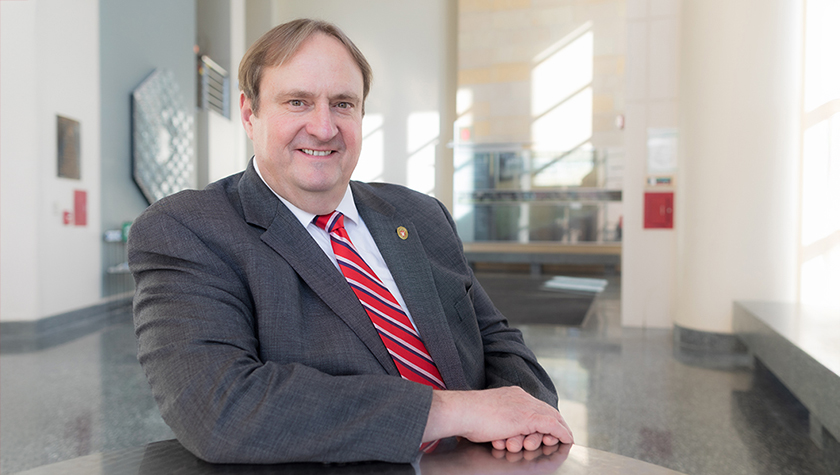
Dear School of Pharmacy Alumni & Friends,
In recent months, the Trump administration has been working to advance their America First administrative priorities. As of this writing, late-March 2025, the President has signed 89 executive orders that have impacted a wide array of policies. Another way that the administration has implemented its policy priorities is through Cabinet appointees. Cabinet secretaries set the agenda and direction of critical departments of the federal government and serve important roles in implementing an administration’s strategic priorities. Here I discuss two policies recently implemented by the administration that impact our operations at the University of Wisconsin–Madison School of Pharmacy: one affecting diversity, equity and inclusion (DEI) activities and another National Institutes of Health (NIH) funding. Both policies are being challenged in federal court.
The President has, through executive orders and Cabinet-level communications, made it clear that DEI programs within the federal government will be terminated and federal funding for extramural DEI programs will cease. A case was brought before a U.S. District judge who, on February 14, issued a preliminary injunction against two executive orders ending DEI program funding. But on March 14, the block was lifted by a three-judge panel of the Fourth U.S. Circuit Court of Appeals. Clearly this topic is a matter of hot debate among jurists as well as partisans. Higher education is right in the middle of this battle. The plaintiffs in the DEI motion cited above include the National Association of Diversity Officers in Higher Education, and the American Association of University Professors.
Our diversity efforts at the School of Pharmacy are rooted in our commitment to the Wisconsin Idea, which is UW–Madison’s guiding principle that what we do in Madison — the ideas we develop and the people we educate and train — will have a positive impact all across the state and beyond. As a pharmacy school, we prepare students to serve as the medication experts in the healthcare system. The graduates of our PharmD program serve Wisconsinites as pharmacists in a wide variety of healthcare settings across our state. Unfortunately, there are many “pharmacy deserts” across the nation, including here in Wisconsin, where patients have limited access to pharmacists and vital pharmacy services. These deserts occur in both urban and rural areas. For example, in Milwaukee’s Black and Latinx neighborhoods, residents have among the worst access to pharmacies in the country. Access to pharmacies in rural communities is declining. According to a recent study, people who live in small rural areas are also at risk for pharmacy access issues.
To address pharmacy deserts in Wisconsin’s urban and rural communities, we recruit students who may choose to return to practice in those areas after graduation. The rationale is that students recruited from a particular area have family or other ties that make them likely to return to establish their careers. In our efforts to build a diverse and excellent class, we also recruit candidates across Wisconsin and beyond. This diversity of each class is an important strength of our school. Students with diverse backgrounds and experiences, of viewpoints and perspectives, bring fresh thinking that provide opportunities for students to learn from the faculty and each other.
Another area that concerns us greatly is potential cuts to federal funding for research vital for driving innovations that improve our lives, provide for our defense, and power our economy. For example, the NIH, the largest source of federal funding that UW–Madison receives, recently announced a cap on indirect costs for grants.
As the name implies, indirect costs don’t support a research project directly but are critical for maintaining the infrastructure needed for any type of research project. Examples include the costs associated with maintaining the buildings and the labs within them, the electricity to power them, the plumbing and ventilation systems, and so on. Indirect costs also fund people such as the dedicated and highly skilled tradespeople and engineers who keep our facilities functional and safe places to work and study. Research administrative staff help assemble and submit grants and contracts to funding agencies and oversee compliance and appropriate spending of the funding received.
Without funding for indirect costs, our faculty, staff, and students would not be able to conduct their research. In short, the NIH indirect costs fund the infrastructure of publicly funded biomedical science in the United States. A recent study found that research spending on new drug approvals by the NIH was not less than that of the pharmaceutical industry. This suggests that a significant decrease in NIH funding may significantly impact the pipeline for vital new drugs. For now, the NIH cap on indirect costs has been challenged in court and a U.S. district judge has issued a temporary injunction halting implementation of the cap across the country until the issue can be fully litigated.
The U.S. has traditionally been the great melting pot of cultures and ideas. It has the largest, most innovative, and productive economy in the world. Certainly, there is room for greater efficiency, and we would welcome the opportunity to work with federal agencies to explore this thoughtfully and in a way that doesn’t slow the kinds of life-changing discovery and innovation for which American universities are known.
Steven M. Swanson
Dean and Professor
UW–Madison School of Pharmacy